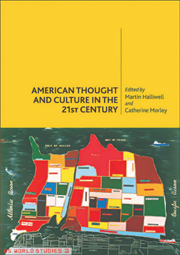Book contents
- Frontmatter
- Contents
- Acknowledgements
- Notes on the Contributors
- Introduction: The Next American Century?
- PART 1 POLITICS
- PART 2 SOCIETY
- PART 3 CULTURE
- 13 Contemporary American Culture
- 14 Cultural Pluralism and National Identity
- 15 Writing in the Wake of 9/11
- 16 American Ways of Seeing
- 17 Television and Digital Media
- 18 Animation and Digital Culture
- Bibliography
- Index
16 - American Ways of Seeing
from PART 3 - CULTURE
Published online by Cambridge University Press: 05 August 2013
- Frontmatter
- Contents
- Acknowledgements
- Notes on the Contributors
- Introduction: The Next American Century?
- PART 1 POLITICS
- PART 2 SOCIETY
- PART 3 CULTURE
- 13 Contemporary American Culture
- 14 Cultural Pluralism and National Identity
- 15 Writing in the Wake of 9/11
- 16 American Ways of Seeing
- 17 Television and Digital Media
- 18 Animation and Digital Culture
- Bibliography
- Index
Summary
In 1936 Henry Luce, the founder of Life magazine, famously articulated the magazine's purpose:
To see life; to see the world; to eyewitness great events; to watch the faces of the poor and the gestures of the proud; to see strange things – machines, armies, multitudes, shadows in the jungle and on the moon; to see man's work – his paintings, towers and discoveries; to see things thousands of miles away, things hidden behind walls and within rooms, things dangerous to come to; the women that men love and many children; to see and to take pleasure in seeing; to see and be amazed; to see and be instructed; thus to see, and to be shown, is now the will and new expectancy of half mankind.
The truth of Luce's emphasis on a new way of seeing and a new will to see refers to a visual history of America and of its interactions with the rest of the world that stretches well beyond the history of the picture magazines. What Luce celebrated and Life illustrated in the mid-20th century was an American way of seeing: that is, a way of seeing the world that is visually codified and thematised by the national concerns of the United States. This American way of seeing is at once democratic and imperial: democratic, in that it seeks to represent the diversity of humanity, to see and to show the activities, hopes and fears of ordinary peoples, and bear witness to their sufferings; imperial, in that it privileges and distinguishes an American point of view that is commensurate to America's powerful role in world affairs.
- Type
- Chapter
- Information
- American Thought and Culture in the 21st Century , pp. 259 - 274Publisher: Edinburgh University PressPrint publication year: 2008



